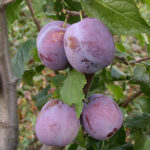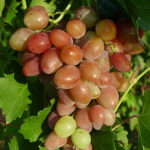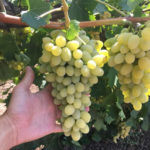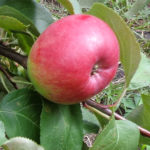Hydrangea paniculata Pink lady
The choice of varieties of hydrangea paniculata at the moment is simply huge. Lovers of noble floral cultures want to get as many representatives of this species as possible in their collection. Of course, this is not so easy to do if you are on a limited budget. But here's the best of the best to get real. According to the British Royal Society of Gardeners, the most popular variety of the mentioned flower today is the beauty with the aristocratic name Pink Lady. She has every chance to turn your flower garden into a piece of paradise.
History of appearance
This variety was bred by the breeder from Holland Peter Zweinenburg. He worked on the creation of this variety of ornamental flowering shrub for two decades, dedicating his activities to the 70s and 80s of the last century. A significant role in the appearance of the Pink Lady was played by Zweinenburg's use of the heritage of other specialists - Robert and Helena de Belder. The members of the Royal Horticultural Society, mentioned above, gave the variety the highest rating, placing it on a par with such well-known hydrangea varieties such as Kyushu, Pinky Winky and Limelight.
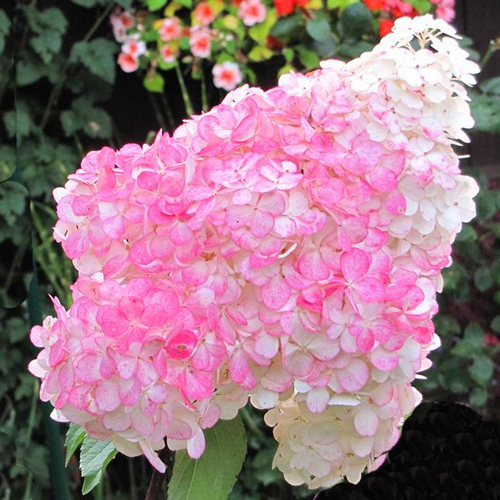
Description of appearance and features
Pink Lady looks very elegant. It is a shrub with a height of 1.5 to 2 meters and a width of up to 200 cm, with a spreading lush crown, expanding towards the top and thus resembling a fan in its shape. The long, straight shoots of the plant are brown in color. As autumn approaches, their color changes to reddish. The stems are covered with large, slightly elongated ovoid leaves of a rich green hue, with finely toothed edges. The length of each leaf varies from 10 to 15 cm.
The most attractive part of the plant is, of course, the inflorescences. They are endowed, without exaggeration, with divine beauty: delicate, large, conical, consisting of medium-sized bisexual flowers (about 3 cm in diameter) with four rounded petals. Like most hydrangeas, this variety is characterized by a gradual change in the shades of the inflorescences. Initially, the flowers are snow-white. Then the inflorescences acquire a greenish tint, later - cream. In the phase of complete dissolution, the flowers turn pale pink. Hence the name of the variety: Pink Lady, which in English means "Pink Lady". The length of the flower cones is 15-25 cm. This is the phase of the complete dissolution of the Pink Lady flowers. The bush inflorescences are very fragrant. Their subtle fragrance contains sweetish notes. The hydrangea blooms for a long time. It lasts from the second half of July until the first autumn frosts.
The advantages of the plant include: the preservation of a powerful bush in shape (in other words, it does not disintegrate during flowering) and the stiffness of the shoots (the stems do not bend under the weight of lush inflorescences), unpretentious care, high winter hardiness (withstands frosts down to -29 ° C).

Growing and care
Pink Lady grows best in partial shade and in diffused sunlight (openwork shade). It is highly undesirable to expose the hydrangea to direct sunlight - this helps to reduce the size of the inflorescences that appear, slow down the growth and development of the shrub. Protect the place where you placed your pet from cold drafts.
Pink Lady should be planted in loose soil with a high degree of fertility and a pH level of 4 to 6.5. Since the variety prefers an alkaline acidic soil, avoid adding wood ash and lime to the substrate. The optimal composition of the soil mixture used for planting a culture is as follows: 2 parts of leaf land, 2 parts of humus, 1 part of peat and sand. This variety loves sandy soils. Do not forget about drainage, which can be small pebbles. Lay it on the bottom of the planting pit, the depth of which should be about half a meter. Add a mixture of fertilizers there (potassium sulfate and urea - 25 grams each, superphosphate - 65 grams, a little pine needles). Fill the hole with soil next.Maintain a distance of 100 cm between bushes.
Hydrangea needs regular weekly watering. Each plant needs about 20 liters of soft water at room temperature at a time. After watering, the soil around the plant must be loosened to maintain the air permeability of the earth. Perform this procedure carefully so as not to damage the roots of the Pink Lady. An important event for this variety is mulching. Sawdust, peat, spruce needles can serve as mulch.
An ornamental plant is responsive to feeding. Once you plant the Pink Lady outdoors, fertilize the soil under the flower with an aqueous solution of manure. A little later, add a concentrate containing sufficient doses of potassium, phosphorus and nitrogen to the soil under the bush. Hydrangeas need similar feeding during the period of active growth and in the budding stage. When the beauty is covered with lush inflorescences, carry out two more mineral dressings with a gap of 15-20 days.
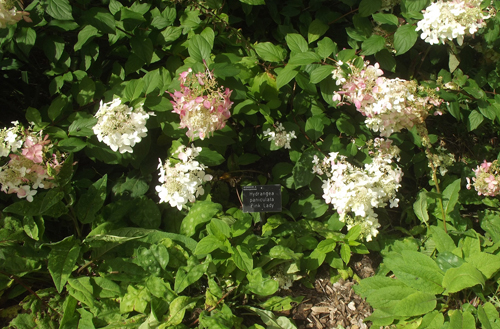
For abundant and lush flowering, the shrub is pruned. In the spring, remove old shoots, frozen and dry branches, but do this before the sap flow begins. A feature of Pink Lady is the fact that inflorescences are formed only on new branches.
Given the high resistance of the shrub to cold weather, it is not necessary to cover it for the winter. But if you still do not want to neglect this event, build a frame over the plant and cover it with some kind of insulation material. Alternatively, bend the shoots to the ground and give the hydrangea a flat, dry shelter.
The shrub can get sick, especially in damp and cold weather. Most of all, Pink Lady is threatened by fungal infections, for example, powdery mildew. For the treatment and prevention of this trouble, experts recommend the use of fungicides such as "Fundazol" or "Topaz". An aqueous solution of the drug is simply sprayed on the bush. Of the pests, the variety is capable of harming aphids. They fight it by treating the plant with Fitoverm or Aktofit insecticides.
Use cases
In landscape design, Pink Lady is actively used for landscaping parks and squares, gardens, front gardens and personal plots. She favorably emphasizes the charm of group compositions. Pink Lady looks especially good in a company with conifers and evergreens. Shrubs of this variety of panicle hydrangea look equally luxurious as part of a mixborder or hedge. The main thing is to remember the width to which the culture grows, and leave enough space around the bush when forming various garden compositions with its participation.
